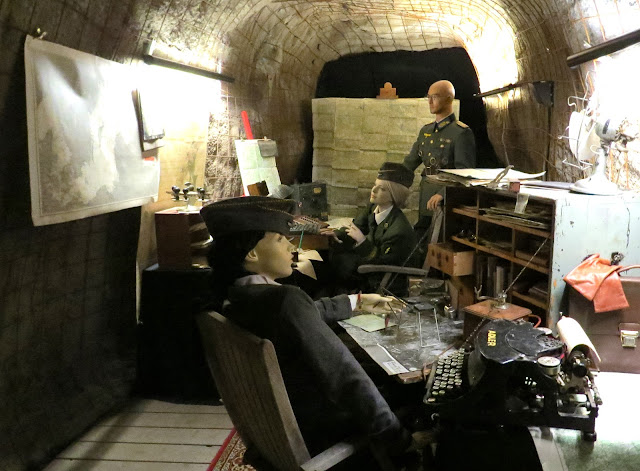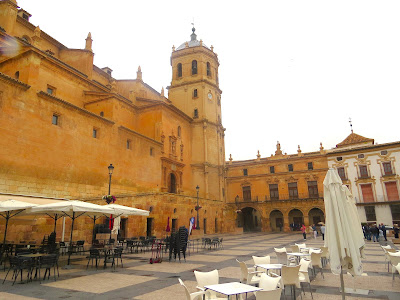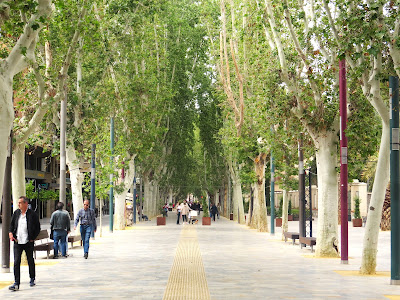 |
| Cartoons decorate scaffolding at Murcia's Cathedral Square. Light-hearted public art and activities seem to be the norm in this cheerful town. You can use your fingers to zoom in on the drawings. |
Murcia was the least touristy of all the places we stayed during our spring 2024 trip to Spain. There's not much in the way of tourist attractions is this city of almost a half-million people. It may not be a great place to visit, but I suspect it's a pleasant place to live.
We spent four nights, April 17 to 20, at the Hotel Cetina Murcia, a not-great hotel in a great location in the city's small old quarter. Driving to the hotel eventually involved calling the desk to have someone come to us a block or two away and get barricades lowered on a pedestrian street so our car and our luggage could reach the front door. We then parked the car in a public garage several blocks away.
Murcia is known for two festivals, Holy Week celebrations and a spring flower festival. We were here for neither, but slightly sad-looking flowers still adorned many buildings, including the stately city hall.
This was the only time during this trip that we used our rental car (a high-tech Ford Focus hybrid) for anything other than driving to the next city on our itinerary. We had four nights and three full days here, and on Thursday we drove south to the Mediterranean and Cartagena. We visited a cave bunker that was used during the Spanish Civil War and a maritime museum. We had lunch at a busy brasserie on the waterfront.
On Friday, a damp and overcast day, we drove about an hour into the mountains to Lorca, a picturesque town of centuries-old buildings. We simply walked around the town and had lunch. That Friday evening, back in Murcia, we were having drinks at a sidewalk cafe on the marble-paved, tree-lined and pedestrian Gran Via when a police car came through moving people out of the way. It was followed by hundreds of in-line skaters, some in costume, racing en mass, some with dogs on leashes, some with small children pedaling madly on little bicycles. It took several minutes for them to pass our table. I had neither my phone nor my camera with me, so you'll have to trust me that it was quite a sight.
Our last day, a Saturday, Murcia surprised us again, this time with free piano concerts in the street at two different locations, a religious procession with oxen pulling an icon on a cart, led by riders on horseback and followed by horse-drawn wagons full of merrymakers. Once more, quite a sight.
Like everyplace else we visited in Spain, tapas were widely available, and we had duck and mushroom cannelloni and sushi among other small bites here. Our only meal of note here was at Hispano, a restaurant across the street from our hotel. We shared a lobster salad in which lobster, not quite as fresh as it should be, was served in a delightful covered dish that looked like a lobster. Then I had lamb shoulder with warm ratatouille and Jane had sea bass. We shared a bottle of Muga Crianza (years ago in Haro in northern Spain we toured the Muga winery because it was the only Rioja winery we could find that had tours in English). Dessert was cheesecake with praline pecans and fig marmalade. Other than the lobster, everything was first-rate, including the service. If you find yourself in Murcia, try to get a reservation here.
Murcia may not be a must-see, but for us it was a glad-we-saw-it. A pleasant town with few of the souvenir shops that fill the old quarters of other towns, no tour groups blindly following guides, no double-deck buses, and no lines for anything. There is a stadium-size bullring, though, but we didn't see it, and many, many churches. We skipped all of them except for the Santa Maria Cathedral, impressive but not as ostentatious as others in southern Spain.
Here are some photos:
 |
| On our daytrip to Cartagena, we visited hilltop Galeras Castle, where the view included this open-air auditorium and the harbor. |
 |
| Also seen from Galeras Castles was this Roman amphitheater. |
 |
| The hill that Galeras Castle sits on is riddled with caves and bunkers that protected local people when Cartagena was bombed by Spanish Fascists and German Nazis during the Spanish Civil War. |
 |
| An exhibit in the Museo-Refugio de la Guerra Civil, the bunkers beneath the ground of Galeras Castle. |
 |
| A pedestrian underpass on the walk between the Civil War bunkers and the Museo Nacional de Arqueologia Subacatica, a museum of maritime salvage housed in a strikingly modern waterfront building. |
 |
| This canon is explained below. It's amazing how cast-iron objects even after centuries underwater retain their makers' marks. |
 |
| This is the Plaza de Espana in Lorca. The cathedral on the left dominates the central part of town. |
 |
| An arched opening connects the Plaza de Espana with a city street. |
 |
| Lorca is nestled among steep mountains. |
 |
| View from the cafe where we had lunch on a rainy Friday afternoon in Lorca. |
 |
| A street scene near our hotel in Murcia. |
 |
| Los Zagales, a tavern where we had tapas our first evening in Murcia. |
 |
| The entrance to the cathedral in Murcia. |
 |
| The cathedral's bell tower. |
 |
| By the standards of southern Spain, the Murcia cathedral's interior is rather restrained. |
 |
| Late afternoon on a plaza near our hotel. |
 |
| The Gran Via. Here we saw hundreds of in-line skaters on a Friday evening. |
 |
| The Episcopal Palace in Murcia. |
 |
| The Segura River flows through Murcia. The cathedral bell tower is in the distance. |
 |
| These riders were the first sign we had on a Saturday morning that some tradition was being re-enacted. |
 |
| These women gave us another hint. |
 |
| The ox cart with a religious icon was probably the focus of the event. |
 |
| Oxen dressed for the day. |
 |
| Somewhat anticlimactic, wagons of people came last. |
 |
| Murcia is a city with a whimsical sense of humor. This municipal building is on a plaza where one of the piano stages was set up. |



No comments:
Post a Comment